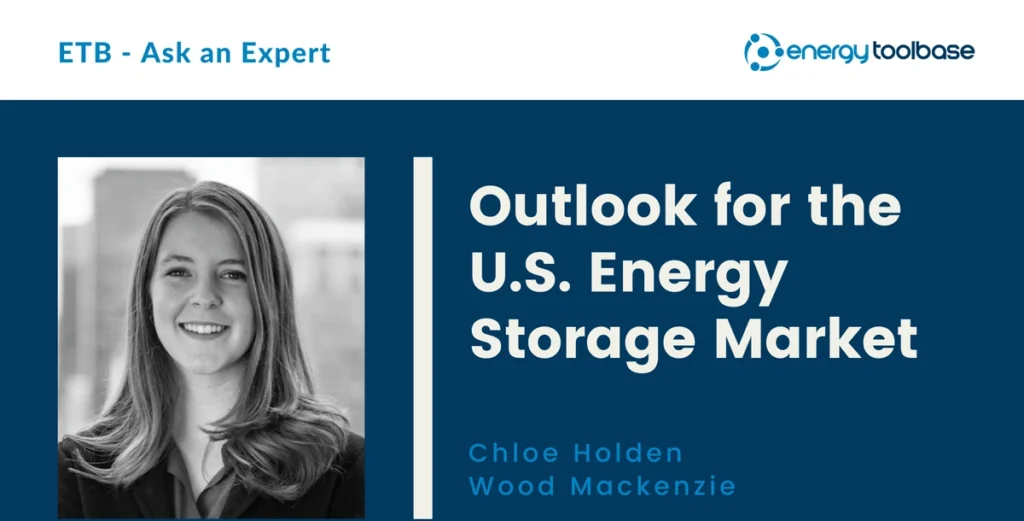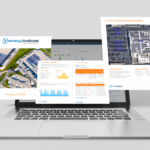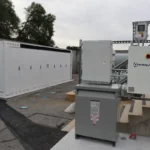In this installment of our “ETB Ask an Expert” interview series, Adam Gerza, VP of Business Development at Energy Toolbase, and our guest, Chloe Holden, discuss all things related to the current state of the U.S. Energy Storage Market. Chloe is an energy storage analyst at Wood Mackenzie (WoodMac), a leading global research and consultancy firm, which is widely regarded as a leader in the energy storage space. With a background in technology commercialization, Chloe’s market analysis focuses on both the U.S. residential and commercial energy storage markets.
In our interview with Chloe, we discussed a number of topics, including the type of work WoodMac does, the U.S. Energy Storage Monitor Report they publish each quarter, the impact the Inflation Reduction Act (IRA) and energy storage tax credit may have on the market, an overview of commercial and industrial (C&I) energy storage, the top C&I state markets and future growth markets, as well as the numerous headwinds and tailwinds blowing in the market.
Listen to the episode of ETB Ask An Expert here:
ETB: The huge story of the day that everybody is buzzing on is the Inflation Reduction Act and the inclusion of the standalone storage ITC. It’s hard to overstate the importance of this bill for solar and storage. What was your and the WoodMac team’s initial reaction that this may happen? (05:15)
Chloe Holden: Yeah, it’s been a real up and down a few weeks; we’d given up earlier and earlier in July on seeing anything pass. And so, I think that while this isn’t the package that was originally hoped for, it was such a relief to see it. It’s looking like it will go through in Congress. So yeah, a huge feeling of relief on the WoodMac team. We’ve fortunately been assuming the passage of the standalone storage ITC and the extension of the solar ITC, so we were kind of vindicated and holding out hope for that. We now do think that that’s going to come through, so that’s a great thing for renewables. Personally, the trade-offs of the bill are still hard to stomach: new pipelines, new drilling for oil and gas… The hope is that the overall emissions impact will be positive, then maybe, we can interrupt some of the other activities that the bill is going to promote.
ETB: WoodMac released data surrounding the effects of the Standalone ITC if it were to pass. One stat mentioned how WoodMac forecasted that the ITC could drive a 20-25% growth in deployments over a five-year period. Can you explain this forecast more? Will the forecast be updated? (07:36)
Holden: As you mentioned, we’ve been assuming that these would pass in our base case forecast, as our most likely scenario. We are still pegging that at 25% additional storage deployment over five years, and that’s for both the storage ITC and solar ITC extension. In my research, my area of focus is residential and commercial storage. I’ll talk about how I’m thinking about the ITC in the residential segment – A solar ITC extension is a critical boost to solar deployment. Every solar installer website you go to talks about the solar ITC, but it’s such an important driver of solar demand because it can shave off system costs for a solar system, and obviously, things change if you add a battery. But what people really want to know at the end of the day on the residential side is, how much am I going to be paying month after month compared to what I’m paying now? Am I locking in a decent rate? So, if you can make that monthly bill more attractive, which the ITC does, you win more deals. And the more solar deals you have, the more storage deals you have, and solar and storage are paired so frequently residentially. Commercially, it’s a similar story. But with the market segment relying more on return on investment – it’s everything in commercial –projects that are already viable are going to become more attractive, and projects that wouldn’t have penciled out before will become viable. So that is going to deliver that additional 20 to 25%, and that’s also including utility-scale which of course, we’ll see gains as well.
ETB: The ITC is arguably one of the biggest tailwinds for the industry. In your report, you characterize market drivers and barriers. In the storage market, what other tailwinds have a big sway on your five-year outlook for deployments? (10:47)
Holden: One that’s on everyone’s mind in storage is the supply chain crunch that we’ve been facing. For residential, that’s been a barrier. We’re seeing installers not push storage as hard as they could be because they don’t have access to batteries or do not have an ideal number of batteries, and it’s also affecting pricing. On the commercial side, we’re seeing project delays and cancellations with changes in quotes, so that’s been a big headwind. Right now, we are expecting the worst part of this supply crunch to end around the end of next year in 2023 as manufacturing capacity increases, but there are lots of variables there. We think global investment in supply & processing and new supply lines will ease some of the supply pressures by 2024. I release the U.S. distributed storage market report annually, and that has a low case, so sort of a more pessimistic forecast. In that forecast, we allow for the possibility that we won’t see things ease up until 2025, 2026, or even later, but the assumption we’re making currently based on what we’re hearing in the market is 2024. We’re going to be seeing things ease up, and so that’s a major headwind. Tailwinds, we’re definitely hoping for new incentives. Commercial storage is really interesting, there’s a lot of activity in the space, and a lot of really amazing companies working hard, but deployment has been a little bit stagnant. Some earlier GTM research forecasts had projected higher commercial storage deployment than we’ve actually seen materialize and that’s because even when projects pencil out, there are a lot of barriers.
ETB: What are your thoughts on why the commercial energy storage market has lagged, particularly relative to the residential segment? (15:33)
Holden: I think the main thing that everyone needs to be aware of is that the drivers for the three segments are just completely different. In grid scale, we’re having these massive procurements. There are storage mandates, there are end goals, and there is the need to balance out renewables on the grid, so we’re seeing utilities move those projects, and of course, the overall project size is massive. One project represents a lot of megawatts and that’s not the same for residential. Residential has been growing really notably and those installations are driven by power outage concerns first and foremost. We have homeowners who are worried about outages who experience outages that are interested in solar. So, it’s this really interesting dynamic where you have a homeowner who has had solar marketed to them as a cost-saving, bill savings tool that they’re going to get a pretty quick return on investment. A few years in some cases, zero down, so it’s an easy yes.
I think for a lot of homeowners, especially in areas where they’re pretty used to seeing solar on the roof and then you hear about a battery which totally changes the economics of the system, it’s this interesting psychological thing where you have someone saying, yes, I’ll save money and produce my own energy. With this add-on a storage system, people call it an emotional decision, and I don’t know if that is always fair to say. I think that it’s a big issue in our industry that you can’t really put a dollar value on resilience. But the value that customers are putting on resilience is high. A lot of these customers who are getting solar decide they’re happy to lock in their solar savings and maybe they’ll use some of those savings to invest in the battery. There’s great financing now for storage and I think installers are making it really easy to say yes to storage there. You’re getting a monthly bill, you’re getting these resilience benefits, and in certain states, it’s maybe worth it in dollar terms because you get a really terrible outage like the Texas freeze in February 2021. In some parts of California where we have recurring outages from the public safety power shut offs. Puerto Rico, of course, where solar is not something everyone can get, but it’s growing very quickly, and storage attachment is at a very high rate. So, we see that driving residential.
On the commercial side, resilience matters, but the primary driver is economic returns. That in and of itself is a tremendous difference. We’re not going to see the same impacts from power outages on demand for commercial storage. We are seeing the impact from resilience demand, but just not as much. It’s an additional benefit, and the economics are good oftentimes for commercial storage. It’s almost a problem of they’re good, but not good enough, so it depends. So much impacts the economics – first of all, they vary widely. They’re impacted by state-specific work that goes into a project, like design, permitting, unique sales processes, varying rate structures you have to account for, and problems with financing. Even for projects where a battery is cost-effective for that customer, they have other competing priorities, and maybe the investment is favorable but not as favorable as a different non-energy investment they could make. Those are some of the main barriers to scale for commercial. There’s a lot of great folks working on that problem, but it’s been a barrier so far for sure.
ETB: For C&I, what are the biggest state markets for commercial storage currently? (21:00)
Holden: The top market for traditional commercial storage is California, leading by a significant margin. Unfortunately, still not a massive market compared to what it could be, compared to the number of commercial businesses that maybe technically could benefit from storage, but California is definitely a leader. That market is helped along by high demand charges, time of use rates that storage can help with, energy arbitrage, plus incentives, plus demand response and other grid services revenue opportunities. So you’re stacking those revenue streams to sweeten the project economics. The same is true in New York and Massachusetts, the other top markets for commercial storage today. There’s still a lot of untapped market potential even in those major markets. Beyond those three, we are currently looking at Connecticut. Definitely some energy in Connecticut right now which is going to get a boost from its new program called “Energy Storage Solutions,” and incentives for that program are drawing developers to the market. The program has an emphasis on resilience and critical facilities, which is always a plus for storage developers, as they can get better compensated for providing those benefits.
We’re also going to see a few more projects in Hawaii, supported by the Battery Bonus program. Texas, New Jersey, and Puerto Rico are all markets that we have forecasted to have some growth in the next five years; moderate growth as more projects move forward, and some of these projects are already in the works. I think we’re going to see, in general around the country, more microgrids and EV charger paired storage, that’s an emerging use case. But the EV charging use case is one that we’re keeping an eye on because as you have these load supernovas that are just popping up in places on the grid that aren’t prepared for them, storage is going to be a pretty important way to help keep demand charges in check, to help the grid, and keep things from breaking down, and that’ll be popping up all over the country.
ETB: It seems like up-and-coming markets like Connecticut and Hawaii are driven by a state incentive program. Is it fair to say that that is one of the drivers for a new state market to come on the scene and make your report in the top 10? It seems like that that is something that possibly expedites market growth where you’ll see developers move in and hopefully deployments to follow. (24:01)
Holden: Incentives are important for sure. I think in a market that is going to be a real leader that it’s not incentives on their own – it’s incentives, it’s great structure, and a strong commercial solar market definitely helps, so it depends. Incentives have been very useful in driving the market, as we seen in California with the self-generation incentive program. But high demand charges and variable rate structures are also likely to drive more storage into the future. So, changes in rate structure could also do that, kind of push a state into the top where it hadn’t been before, so we definitely look for that. And then, resiliency, reliability, corporate sustainability goals, and sometimes commitment to solar and storage as part of that can also contribute. It’s somewhat of a driving force now, but the degree to which that increases over the next five to ten years will be interesting to see because that can also influence things.
ETB: With wholesale grid services a commercial storage project operating behind the meter can tap a revenue stream in front of the meter. Can you share WoodMac’s high-level thoughts on how this is maturing? (28:07)
Holden: Our energy storage monitor report has a five-year forecast, and FERC 2222 starts to influence that toward the tail end a little bit in the out years in 2026. For our 10-year forecast, which some of our other global storage reports share, we do have it playing a larger role. It’s a really interesting and critical area for storage. The timelines are still a little bit up in the air. MISO is kind of coming in with the latest proposed timeline for 2030 – it’s a little ambitious. So, we’ll see if they are pushed to get working on that little earlier. There are very fair barriers to 2022 implementation, so I don’t want to dismiss the software fluency that you need and transparency into your own data. But it’s something that you know needs to be done and hopefully, we’ll get done quickly as grid flexibility becomes an important thing.
CAISO is really interesting, as you mentioned, in some of these top commercial solar plus storage markets and storage markets, we already have these grid service revenues coming in, and revenues from demand response are really key. But they can always be more rewarding, especially if states and legislatures are committing to hitting a certain storage target and understanding the unique value that distributed storage has on the grid, which has been studied. Folks are pretty certain at this point that those distributed resources can play a big role in balancing the grid in a way that having only your utility-scale solar and storage can’t. CAISO responded to FERC Order 2222 by saying we’re doing most of this already, and then storage companies push back saying you could definitely improve, so that’s where we are now. One of the areas that I’m really interested in seeing progress on is injecting power into the grid and the regulatory limits on that are pretty strong right now, but that’s something that storage can do. Categorizing it sort of arbitrarily as generation sometimes is not what we want, but in many cases, storage can effectively act as generation, so when that is treated as valued appropriately under a regulatory framework, I think that that will provide some revenue that storage needs. So, with implementation for 2022 boosting our forecast in the latter 2020s, there are a lot of open questions. Particularly in terms of how much money you can actually get for services provided and which services you can provide, that’s going to be critical to how much additional energy storage gets installed.
ETB: Are there any other noteworthy headwinds or tailwinds that WoodMac is keeping an eye on that we haven’t discussed yet? (33:15)
Holden: Something really interesting about storage is the resiliency factor, and I do think it’ll be of growing importance. Unfortunately, the pressures of climate change, weather, and an aging grid are going to move the needle for more and more corporate and residential customers in the next ten years. And also, just the broader narratives around that. You saw people, kind of in the context of, unfortunately, the high gas prices and the Ukraine-Russia conflict, they maybe aren’t seeing any power outages in their neighborhood, but a sense of energy independence and a sense of reliability and self-sufficiency is valuable in our culture and for sales conversations. So, I’m very interested to see where solar and storage fits in. I think that that is going to be key to the mainstreaming of residential and commercial solar plus storage. We are not in the mainstream yet, and that’s the truth of it. But I think that we will get there certainly within the next five years.
Timestamps:
- 00:00 Introduction, WoodMac, the US Energy Storage Monitor Report
- 05:15 The impact of the Inflation Reduction Act and the standalone storage ITC
- 07:35 WoodMac’s forecast on the standalone storage ITC
- 10:42 The ITC and tailwinds in the storage market
- 15:30 Stunted growth in commercial in comparison to residential
- 21:00 Top C&I state markets and future growth markets
- 24:00 Role of incentives in expediting market growth
- 26:15 Driving factors of demand and deployments, corporate sustainability ESG commitments
- 28:04 Wholesale grid services, WoodMac’s forecasts, FERC No. 2222
- 33:11 Noteworthy headwinds and tailwinds, closing thoughts
Read more about what our team of experts have to say about the Inflation Reduction Act – Federal ITC for solar + storage projectshere
Learn more about the key policy issues in the California solar + energy storage market and access reports on how they affect the economics of projectshere



